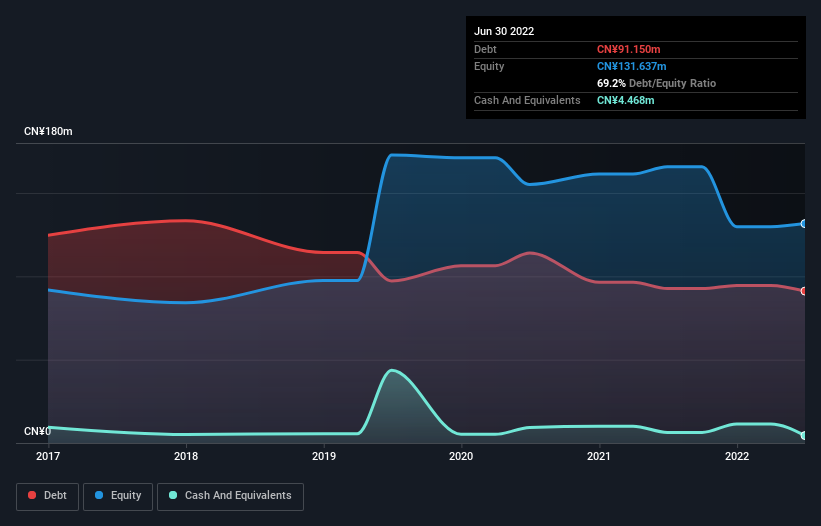Warren Buffett famously said, 'Volatility is far from synonymous with risk.' So it might be obvious that you need to consider debt, when you think about how risky any given stock is, because too much debt can sink a company. As with many other companies Narnia (Hong Kong) Group Company Limited (HKG:8607) makes use of debt. But the real question is whether this debt is making the company risky.
When Is Debt A Problem?
Debt assists a business until the business has trouble paying it off, either with new capital or with free cash flow. In the worst case scenario, a company can go bankrupt if it cannot pay its creditors. However, a more usual (but still expensive) situation is where a company must dilute shareholders at a cheap share price simply to get debt under control. By replacing dilution, though, debt can be an extremely good tool for businesses that need capital to invest in growth at high rates of return. When we think about a company's use of debt, we first look at cash and debt together.
View our latest analysis for Narnia (Hong Kong) Group
What Is Narnia (Hong Kong) Group's Debt?
The chart below, which you can click on for greater detail, shows that Narnia (Hong Kong) Group had CN¥91.2m in debt in June 2022; about the same as the year before. On the flip side, it has CN¥4.47m in cash leading to net debt of about CN¥86.7m.

How Healthy Is Narnia (Hong Kong) Group's Balance Sheet?
We can see from the most recent balance sheet that Narnia (Hong Kong) Group had liabilities of CN¥112.2m falling due within a year, and liabilities of CN¥24.0m due beyond that. Offsetting this, it had CN¥4.47m in cash and CN¥33.3m in receivables that were due within 12 months. So its liabilities outweigh the sum of its cash and (near-term) receivables by CN¥98.3m.
This deficit is considerable relative to its market capitalization of CN¥120.0m, so it does suggest shareholders should keep an eye on Narnia (Hong Kong) Group's use of debt. Should its lenders demand that it shore up the balance sheet, shareholders would likely face severe dilution. The balance sheet is clearly the area to focus on when you are analysing debt. But you can't view debt in total isolation; since Narnia (Hong Kong) Group will need earnings to service that debt. So when considering debt, it's definitely worth looking at the earnings trend. Click here for an interactive snapshot.
In the last year Narnia (Hong Kong) Group's revenue was pretty flat, and it made a negative EBIT. While that hardly impresses, its not too bad either.
Caveat Emptor
Importantly, Narnia (Hong Kong) Group had an earnings before interest and tax (EBIT) loss over the last year. Indeed, it lost a very considerable CN¥13m at the EBIT level. When we look at that and recall the liabilities on its balance sheet, relative to cash, it seems unwise to us for the company to have any debt. Quite frankly we think the balance sheet is far from match-fit, although it could be improved with time. Another cause for caution is that is bled CN¥25m in negative free cash flow over the last twelve months. So in short it's a really risky stock. The balance sheet is clearly the area to focus on when you are analysing debt. However, not all investment risk resides within the balance sheet - far from it. We've identified 4 warning signs with Narnia (Hong Kong) Group (at least 2 which are a bit unpleasant) , and understanding them should be part of your investment process.
If, after all that, you're more interested in a fast growing company with a rock-solid balance sheet, then check out our list of net cash growth stocks without delay.
Valuation is complex, but we're here to simplify it.
Discover if Narnia (Hong Kong) Group might be undervalued or overvalued with our detailed analysis, featuring fair value estimates, potential risks, dividends, insider trades, and its financial condition.
Access Free AnalysisHave feedback on this article? Concerned about the content? Get in touch with us directly. Alternatively, email editorial-team (at) simplywallst.com.
This article by Simply Wall St is general in nature. We provide commentary based on historical data and analyst forecasts only using an unbiased methodology and our articles are not intended to be financial advice. It does not constitute a recommendation to buy or sell any stock, and does not take account of your objectives, or your financial situation. We aim to bring you long-term focused analysis driven by fundamental data. Note that our analysis may not factor in the latest price-sensitive company announcements or qualitative material. Simply Wall St has no position in any stocks mentioned.
About SEHK:8607
Narnia (Hong Kong) Group
An investment holding company, manufactures and sells fabrics in Mainland China, Hong Kong, the United Arab Emirates, Egypt, Brazil, and internationally.
Mediocre balance sheet and slightly overvalued.
Market Insights
Community Narratives





